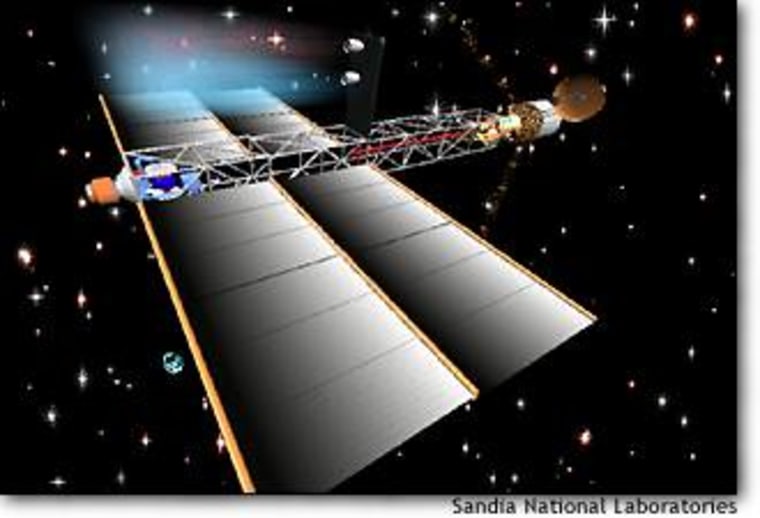Scientists are drawing up plans for what might be called an interstellar “Super-Hubble” telescope. The plans call for a robot-controlled, nuclear-powered cruiser to tow an observatory 50 billion miles or more away from Earth. The challenges involved in turning the concept into reality are ... well, astronomical. But that doesn’t faze the idea’s backers.
“We’re on the first steps of investigating how we take our first steps,” says physicist Roger Lenard.
Lenard and his colleagues at the Energy Department’s Sandia National Laboratories in New Mexico are working with NASA scientists to develop a mission that would send out a probe several times farther than the orbit of Pluto.
The concept was sparked by discussions at NASA’s Jet Propulsion Laboratory last year about an “interstellar precursor mission” that would set the stage for voyages to other stars. The project is under consideration by a science and technology definition team for an interstellar probe, said JPL engineer John West, the team’s leader. He said NASA has provided $1 million for studying such interstellar missions.
A bit premature?
A newspaper article about the telescope project in Monday’s Albuquerque Tribune sparked a wave of interest that some might think is a bit premature. The project doesn’t yet have formal sanction from NASA, or even a catchy name; West calls it “the 550AU gravitational-lens mission study.” JPL spokeswoman Mary Beth Murrill cautioned Tuesday that any interstellar mission was “a long, long way” down the road.
The researchers themselves seconded that view: Sandia scientist Ronald Lipinski said the launch of such a mission is at least a decade away. The probe’s one-ton telescope just might be modeled after the Next Generation Space Telescope, which has not yet been designed. The proposed propulsion system, involving a nuclear fission reactor that would generate a megawatt of electrical power, hasn’t been developed yet.
“The concept of being able to send an object at 100 to 200 kilometers a second (about 225,000 to 450,000 mph) — which exceeds by more than a factor of 10 the fastest object that man has been able to produce — is in and of itself a pretty big breakthrough,” Lenard said.
The distances involved would be enormous: Even at those speeds, the spacecraft would require 14 to 20 years to get to its destination. And since radio signals would take up to three days to get back and forth, the cruiser would have to have an autonomous control system.
Nevertheless, the researchers insist the mission is not beyond the realm of known technologies. “We think that if you wanted to launch this thing before the end of the next decade, it can be done,” Lenard said. He estimated that the expense would be “something on the order of a Galileo-class mission cost” — that is, somewhat more than $1 billion.
Nuclear power
Lenard, who worked on nuclear rocket programs under the “Star Wars” antimissile defense program, said nuclear electric propulsion would be the only way to attain the speeds required for the telescope project.
The idea of using a nuclear fission reactor in space may send a shiver through some environmentalists — just witness the outcry that was raised over the plutonium-powered Cassini mission to Saturn. However, Lipinski argues that the reactor would be similar in size to facilities commonly used at research universities. It would be fueled by enriched uranium rather than plutonium. He also emphasized that the spacecraft would be launched from Earth using chemical rockets rather than a nuclear blast.
“You wouldn’t really turn the reactor on before you launch,” he said. “The amount of radioactivity (before activation) would be less than 1 curie, about the same radioactivity that you have in a couple of truckloads of dirt.”
In addition to the grand telescope project, NASA is considering a less ambitious proposal to send a probe, perhaps with solar sails, on a 20-year journey to explore the boundary between the sun’s magnetic sphere of influence and the interstellar medium, West said. Such a probe would travel 20 billion miles or more from Earth.
West said he expected a study on this mission to be completed in July. Then, he said, “everyone at NASA, all the key decision-makers, will be able to step back and have a fuller picture of just what might be involved.”
“The goal of everyone doing this is to define a concept that is not always beyond the horizon,” West said. “We’re trying to find something that we can do in the next decade.”
The bottom line
All this leads to the big question: Why do it at all?

The researchers say 50 billion miles is a magic number because at that point the sun can be used as a “gravitational lens”: The sun’s gravitational influence would bend light rays to a focus, greatly amplifying the power of a telescope. Lenard said an instrument at the right lensing point could observe faint objects at the universe’s farthest reaches, and even solar systems within distant galaxies.
There are other reasons to get out of the solar system: A distant probe would have a view unobscured by the dust that surrounds the sun and planets. The farther you get from Earth, the easier it would be to create a three-dimensional map of all the stars in our galaxy.
“If you’re ever planning to do some interstellar travel, you need a map. ... We can figure out where the Klingons are and where the Romulans are,” Lipinski said wryly.
The researchers repeatedly emphasized that even their most ambitious plans represented only a first step toward a goal they will never live to see, barring a “Star Trek” miracle. After all, the sun’s nearest stellar neighbor, Proxima Centauri, is about 25 trillion miles away — 500 times farther away than the deep-space telescope would be.
“I call this the second great migration,” Lipinski said. “The first migration is when the fish crawled up onto the land. The second is when people take that first step off Earth. ... It’s absolutely inspiring.”
